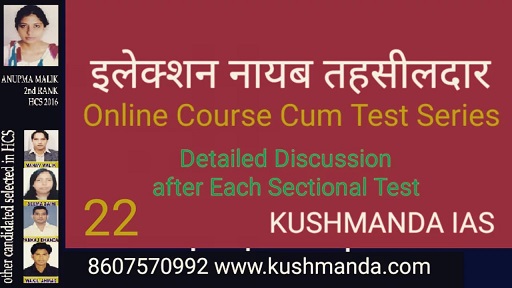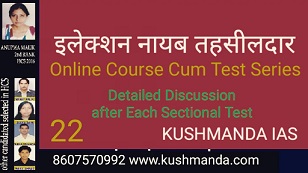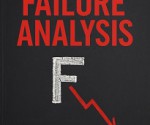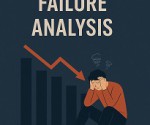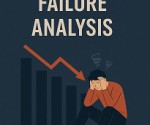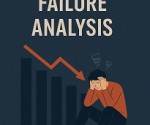Election Naib Tehsildar Online Couse cum Test Series
Election Naib Tehsildar Online Couse cum Test Series
Online Course cum Test Series
- Daily Question Answer Practice for each saction of (Complete syllabus)
- Questions as per new pattern
- Each question will be provided in Hindi and English.
- All doubts will be clarified.
- Personal Guidance will be given for any for any clarification related to the preparation.
Upgrade Your Preparation “Most Practicle, Simple, Focused ,Best & complete approach.” You don’t need to study anything else.
1.The Representation of the People Act, 1951 was commensed on
a) 17 july 1951
b) 16 july 1951
c) 15 july 1951
d) 14 july 1951
Ans A
2.The Representation of the People Act was introduced in Parliament by law minister
a) Dr. B.R. Ambedkar
b) JLNehru
c) Lala Lapatrai
d) Gandhiji
Ans A
3.The Representation of the People Act was enacted by the provisional parliament under
a) Article 327 of Indian Constitution
b) Article 326 of Indian Constitution
c) Article 325 of Indian Constitution
d) Article 324 of Indian Constitution
Ans A
4.In Lok Sabha,The Representation of the People (Amendment) Bill, 2016 was introduced by
a) Varun Gandhi
b) Sonia Gandhi
c) Rahul Gandhi
d) Narender Modi
ANS A
5. Meaning of constituency is contained in
a) Section 3 of The Registration of Electors Rules, 1960
b) Section 4 of The Registration of Electors Rules, 1960
c) Section 5 of The Registration of Electors Rules, 1960
d) Section 6 of The Registration of Electors Rules, 1960
ANS A
6. Form and languages of roll.— is contained in
a) Section 4 of The Registration of Electors Rules, 1960
b) Section 5 of The Registration of Electors Rules, 1960
c) Section 6 of The Registration of Electors Rules, 1960
d) Section 7 of The Registration of Electors Rules, 1960
ANS A
7. Public notice of intended election.— is contained in
a) Section 3 of the conduct of election rules 1961
b) Section 1 of the conduct of election rules 1961
c) Section 2 of the conduct of election rules 1961
d) Section 34 of the conduct of election rules 1961
ANS A
8. Nomination paper.— is contained in
a) Section 4 of the conduct of election rules 1961
b) Section 3 of the conduct of election rules 1961
c) Section 1 of the conduct of election rules 1961
d) Section 2 of the conduct of election rules 1961
ANS A
9. The first general elections in India were held in:
| (a) | 1949 |
| (b) | 1950 |
| (c) | 1951 |
| (d) | 1947 |
Ans: (c)
10. The Congress lost its monopoly of power in the States for the first time after the elections of:
(a) 1967
(b) 1971
(c) 1977
(d) 1955
Ans: (a)
11. The State Election Commission can be removed from office:
(a) only by the Governor
(b) in the same manner and on the same grounds as a Judge of the Supreme Court
(c) only by the President on the advice of the Chief Justice of the concerned State
(d) in the same manner as the Vice-President of India
Ans: (b)
12. Electioneering has to stop in a constituency:
(a) one day before the election
(b) 48 hours before election starts
(c) 36 hours before a poll commences
(d) 48 hours before the closing hour of polling
Ans: (d)
13. Who is responsible for the registration of voters?
(a) Government
(b) Voters
(c) Political parties
(d) Election Commission
Ans: (d)
14. Who can cast their votes by postal ballot?
1. Members of the Armed Forces.
2. Officials on election duty.
3. Foreign Service personal when posted abroad. (a) I and III
(b) II and III (c) III only
(d) I, II and III
Ans: (d)
15 In the election of the President, the value of the vote of the Lok Sabha members:
(a) is same
(b) differs according to the geographical size of the respective State
(c) differs according to the number of votes a member represents
(d) None of the above
Ans: (c)
16. The President can be removed by the way of impeachment which can be made only:
(a) by the Supreme Court
(b) by the Rajya Sabha
(c) by the Members of Lok Sabha and Rajya Sabha through impeachment
(d) cannot be impeached
Ans: (c)
17. In the election of the President, each Member of the electoral college has:
(a) one vote
(b) as many votes as there are candidates
(c) one vote with value attached to it
(d) one vote with value attached to it and he can give as many preferences as there are candidates
Ans: (d)
18. The value of a vote of a Member of Parliament for the election of the President is determined by dividing the:
(a) nation’s population as per the latest census by the number of Lok Sabha members
(b) nation’s population as per the latest census by the total strength of the two Houses of Paliament
(c) the total value of votes of members of all the State Legislative Assemblies by the elected Members of the two Houses of Parliament
(d) particular State’s population as per the latest census by the number of Members of Parliament elected from that State
Ans: (c)
19. Which of the following statements is correct ?
(a) The President may continue to be a member of Parliament even after assuming charge of the Presidential office
(b) The President is not barred from holding any other office of profit even after assuming charge of Presidential office
(c) The President is entitled to use his official residence only on payment of rent fixed
(d) The emolument and allowances of the President shall not be diminished during his term of office
Ans: (c)
20.The first Federal Court in India was constituted under the
a) Regulating Act of 1773
b) Councils Act of 1891
c) Morley Minto Act, 1909
d) Government of India Act, 1935
Solution: D
Justification: The Federal Court of India was a judicial body, established in India in 1937 under the provisions of the Government of India Act 1935, with original, appellate andadvisory jurisdiction. It functioned until 1950, when the Supreme Court of India was established. The seat of the Federal Court was at [Delhi]. There was a right of appeal to the Judicial Committee of the Privy Council in London from the Federal Court of India. The Federal Court had exclusive original jurisdiction in any dispute between the Central Government and the Provinces. Initially, it was empowered to hear appeals from the High Courts of the provinces in the cases which involved the interpretation of any Section of the Government of India Act, 1935. From January 1948 it was also empowered to hear appeals in those cases, which did not involve any interpretation ofthe Government of India Act, 1935
21.The Indian Penal Code (IPC), which was adopted by India post-independence, owes its origin to which of the following timelines?
a) Near the passing of the Charter Act, 1861
b) With the passing of the Regulating Act of 1773
c) It was passed as a part of the Government of India Act, 1935
d) Enacted with the Rowlatt Act near the Non-cooperation movement, 1919
Solution: A
Justification: The Indian Penal Code (IPC) is the main criminal code of India. It is a comprehensive code intended to cover all substantive aspects of criminal law. The code
was drafted in 1860 on the recommendations of first law commission of India established in 1834 under the Charter Act of 1833 under the Chairmanship of Thomas Babington Macaulay. It came into force in British India during the early British Raj period in 1862. However, it did not apply automatically in the Princely states, which had their own courts and legal systems until the 1940s. The Code has since been amended several times and is now supplemented by other criminal provisions.
22.India ceased to be a British dominion on
a) The formation of a constituent assembly in 1946
b) Passage of the Indian Independence Act, 1947
c) 15th August, 1947
d) 26th January, 1950
Solution: D
Justification: Till the passage of the Indian Independence Act, 1947, India was a dependency (colony) of the British Empire. From August 15, 1947 to January 26, 1950, India’s political status was that of a dominion in the British Commonwealth of Nations. India ceased to be a British dominion on January 26, 1950, by declaring herself a sovereign republic. However, Pakistan continued to be a British Dominion until 1956.
23.Which of the following acts abolished the office of the Viceroy?
a) Government of India Act, 1935
b) Indian Independence Act, 1947
c) Government of India Act, 1858
d) Indian Councils Act, 1892
Solution: B
Justification: The Act abolished the office of viceroy and provided, for each dominion, a governor- general, who was to be appointed by the British King on the advice of the dominion cabinet. His Majesty’s Government in Britain was to have no responsibility with respect to the Government of India or Pakistan. It also abolished the office of the secretary of state for India and transferred his functions to the secretary of state for Commonwealth Affairs.
24. It created a new office, Secretary of State for India, vested with complete authority and control over Indian administration and provided that India henceforth was to be governed by, and in the name of, Her Majesty:
a) Pitt’s India Act, 1784
b) Morley Minto Act, 1909
c) Government of India Act, 1858
d) None of the above
Solution: C
Justification: Option A: It distinguished between the commercial and political functions of the Company. It allowed the Court of Directors to manage the commercial affairs but created a new body called Board of Control to manage the political affairs. Thus, it established a system of double government. Thus, the act was significant for two reasons: first, the Company’s territories in India were for the first time called the ‘British possessions in India’; and second,
the British Government was given the supreme control over Company’s affairs and its administration in India. Option C: It provided that India henceforth was to be governed by, and in the name of, Her Majesty. It changed the designation of the Governor-General of India to that of Viceroy of India. He (viceroy) was the direct representative of the British Crown in India. Lord Canning thus became the first Viceroy of India. It ended the system of double government by abolishing the Board of Control and Court of Directors. It created a new office, Secretary of State for India, vested with complete authority and control over Indian administration. The secretary of state was a member of the British cabinet and was responsible ultimately to the British Parliament.
25.During the rule of the East India Company, the council of the Governor-General of India had
a) Only Executive responsibilities
b) Only Legislative responsibilities
c) Both Executive and Legislative responsibilities
d) Neither Executive nor Legislative responsibilities and was only an advisory body
Solution: C
Justification: The council had four members of the Council elected by the Court of Directors. The first three members were permitted to participate on all occasions, but the fourth member was only allowed to sit and vote when legislation was being debated. In 1858, the British Crown took over the administration from the East India Company. The council was transformed into the Imperial Legislative Council, and the Court of Directors of the Company which had the power to elect members of the Governor-General’s Council ceased to have this power. Instead, the one member who had a vote only on legislative questions came to be appointed by the Sovereign, and the other three members by the Secretary of State for India.
PDF ELECTION NAIB TEHSILDAR SET 22 download
Upgrade Your Preparation
“Most Practicle, Simple, Focused ,Best & complete approach.” You don’t need to study anything else.
What you will get:
- 40 Full Test (printed ,Updated, Based on latest pattern)
- Online Detailed Discussion
- Most Expected & Probable Questions Sets
- Expert Support ( personal guidance)
- Medium:ENGLISH/HINDI
Fee- Rs 8500/-
We have an edge over others in Distance Learning Programs through our unique teaching and learning techniques.
Why students should join us?
In this exam “what to study” and “how to study” are the two important factors for success. To solve Exam Specific Questions(Expected Questions) gives you the proper knowledge about the exam pattern(the best answers) as well as makes you sharpen in your speed. By this practise you will get great positive energy . We are ready to help/support you .
Only one single call our helpline
08607570992,09728926678
Fee has to be paid-by Cash on Delivery or Credit Card or NET BANKING(IMPS/NEFT) or by DD/Cheque for the full amount favoring KUSHMANDA IAS HCS ACADEMY payable at PANIPAT . “Trust, quality and reliability , the bywords for KUSHMANDA IAS HCS ACADEMY, will remain our guiding force for Exam.”
“Making good decisions is a crucial skill at every level. You should not waste this opportunity for just a sake of only appearing the examination. Give this attempt with the full fire. So join us immediately.”
KUSHMANDA IAS HCS ACADEMY
C-100, TDI CITY,
PANIPAT
HARYANA
Helpline: 08607570992, 09728926678
KINDLY SEND EMAIL US kushmandaeducation@gmail.com
Or call us 08607570992,09728926678












